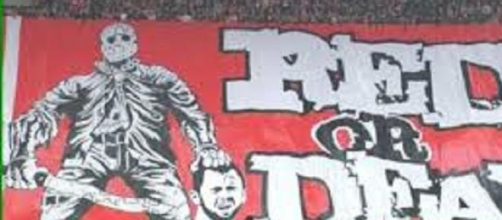In the continuation of the article on Football's obsession with banners and the potential sinister overtures that may be behind them, part two covers what may have been behind the Standard Liege example. It also looks at other examples of banners being used across the world.....
The Belgian Football Federation have promised to look into the matter, although in their view there is nothing within the rules of the game to prevent such banners from being displayed at games. Standard Liege do allow banners to be brought into their stadium by supporters but since late in 2013 (upon consultation with the local police) have sought to apply strict rules relating to their content, after a banner depicting an image from the film Scarface entered the ground in another game with Anderlecht.
It is claimed that given the size of the banners (which are therefore rolled up when brought along), fans are asked to show an image of their banner before being allowed to bring it into the ground. It has been claimed that an alternative image had been shown, so they allowed the controversial banner through.
Worryingly, the offensive banner seems to have been made and sponsored by the Ultras Inferno 96 club, a fanatical element of Standard Liege's fans who gain their inspiration from the 'Ultras' in Italy and France. Large banners are typically used by them along with fireworks and megaphones to incite the crowd. Their 'capos' (leaders) commonly pull their hoods up to avoid identification by the authorities.
Banners at football grounds are commonplace, and even at the game in question at the weekend, were not all deeply offensive. An alternative giant banner (or "tifo") sponsored by the Publik Hysterik supporters' club featured an image of a clown eating the club symbol of the away team.
There have been previous banners of a less seemly nature displayed by Standard fans in the past though, as besides the Scarface depiction, another incident occurred back in 2002.
As with Defour when his signing was made known, they had dubbed the Croatian striker Ivica Mornar a "traitor", and a small group of fans displayed a banner with the chilling message: "We deal with traitors like in your country" (in reference to the civil war in Yugoslavia).
Spurs' fans and players were deeply agitated during last year's Europa League game against Partizan Belgrade, when an alleged anti-Semitic banner was displayed by the Partizan fans, causing UEFA to investigate the matter.
There was also an incident in 2013 in Seoul, when a giant banner was unfurled during the South Korea versus Japan international match by the home fans. That was intended to draw reference to the Japanese occupation of South Korea between 1910 and 1945 by reading as: "There is no future for a people that have forgotten history".
In England, large banners at football grounds are typically used to express dissatisfaction with the manager or the owner, or even to have a bit of a laugh at a player or a previous incident in a game. Manchester United used theirs to show support for David Moyes during his troubled time in charge last season, with imagery depicting "The Chosen One". It has since been withdrawn after Moyes left the club.
